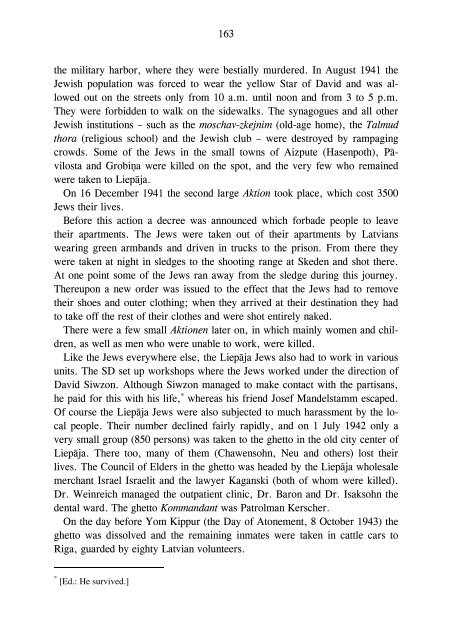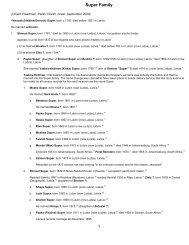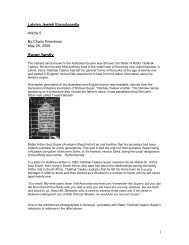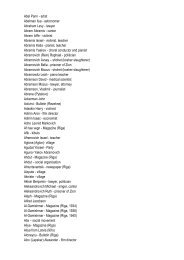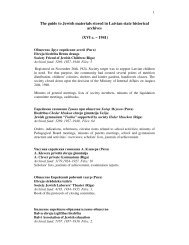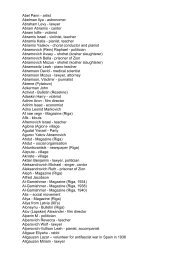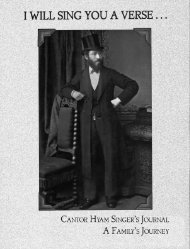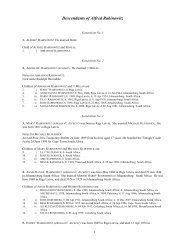Small Riga Ghetto
Small Riga Ghetto
Small Riga Ghetto
Create successful ePaper yourself
Turn your PDF publications into a flip-book with our unique Google optimized e-Paper software.
163<br />
the military harbor, where they were bestially murdered. In August 1941 the<br />
Jewish population was forced to wear the yellow Star of David and was allowed<br />
out on the streets only from 10 a.m. until noon and from 3 to 5 p.m.<br />
They were forbidden to walk on the sidewalks. The synagogues and all other<br />
Jewish institutions – such as the moschav-zkejnim (old-age home), the Talmud<br />
thora (religious school) and the Jewish club – were destroyed by rampaging<br />
crowds. Some of the Jews in the small towns of Aizpute (Hasenpoth), Pāvilosta<br />
and Grobiņa were killed on the spot, and the very few who remained<br />
were taken to Liepāja.<br />
On 16 December 1941 the second large Aktion took place, which cost 3500<br />
Jews their lives.<br />
Before this action a decree was announced which forbade people to leave<br />
their apartments. The Jews were taken out of their apartments by Latvians<br />
wearing green armbands and driven in trucks to the prison. From there they<br />
were taken at night in sledges to the shooting range at Skeden and shot there.<br />
At one point some of the Jews ran away from the sledge during this journey.<br />
Thereupon a new order was issued to the effect that the Jews had to remove<br />
their shoes and outer clothing; when they arrived at their destination they had<br />
to take off the rest of their clothes and were shot entirely naked.<br />
There were a few small Aktionen later on, in which mainly women and children,<br />
as well as men who were unable to work, were killed.<br />
Like the Jews everywhere else, the Liepāja Jews also had to work in various<br />
units. The SD set up workshops where the Jews worked under the direction of<br />
David Siwzon. Although Siwzon managed to make contact with the partisans,<br />
he paid for this with his life, * whereas his friend Josef Mandelstamm escaped.<br />
Of course the Liepāja Jews were also subjected to much harassment by the local<br />
people. Their number declined fairly rapidly, and on 1 July 1942 only a<br />
very small group (850 persons) was taken to the ghetto in the old city center of<br />
Liepāja. There too, many of them (Chawensohn, Neu and others) lost their<br />
lives. The Council of Elders in the ghetto was headed by the Liepāja wholesale<br />
merchant Israel Israelit and the lawyer Kaganski (both of whom were killed).<br />
Dr. Weinreich managed the outpatient clinic, Dr. Baron and Dr. Isaksohn the<br />
dental ward. The ghetto Kommandant was Patrolman Kerscher.<br />
On the day before Yom Kippur (the Day of Atonement, 8 October 1943) the<br />
ghetto was dissolved and the remaining inmates were taken in cattle cars to<br />
<strong>Riga</strong>, guarded by eighty Latvian volunteers.<br />
* [Ed.: He survived.]


